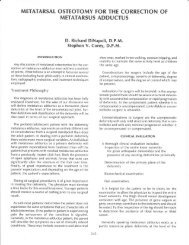Absorbable Screw Fixation - The Podiatry Institute
Absorbable Screw Fixation - The Podiatry Institute
Absorbable Screw Fixation - The Podiatry Institute
Create successful ePaper yourself
Turn your PDF publications into a flip-book with our unique Google optimized e-Paper software.
CFIAPTER 11 63fusion techniques with metallic fixation that requireprolonged periods of non-weight bearing.However, the pertinence of stress-shielding orstress-protection osteopenia in forefoot surgery islikely more procedure specific. For example, in thetechnique of hallux interphalangeal joint fusion,the absorbable screw does not seem advantageous.Stress shielding at this site is minimal, and if screwremoval is necessary, it is easily performed underlocal anesthesia. Metallic flxation also subjectivelyoffers firmer purchase and compression in theproximal phalanx than the absorbable screws.However, the forces acting upon a first metatarsalproximal osteotomy or a midfoot fusion are signiticantlylarger due to the unique biomechanics of thefoot in gait. <strong>The</strong> reduction of stress shieldingafforded by the less rigid absorbable screws mayencourage more rapid and solid osseous consolidationin these applications, similar to the successnoted in ankle fusions.<strong>Absorbable</strong> screws do contribute a potentialsoft tissue complication that must be clearly understood.This transient soft tissue reaction has beenextensively studied since it was first noted with theearly development of polyglycolide rods.3 <strong>The</strong>exact reason for the reaction is unknown, butappears to be a unique foreign body reaction to theraw materials, alpha-hydroxy polyesters. Currently,there is no evidence that the reaction is immunologicallymediated or infectious in nature. A lowerincidence has been reported since the removal ofthe aromatic quinone (green) dye from the firstgeneration polyglycolide rods and screws, but thisis also clearly not the only factor. Since the adventof the colorless raw materials used to make thescrews, the reported incidence of tissue reactions isless than 4ol0.'<strong>The</strong> development of a clinically manifestedreaction seems to be associated with the phase ofliquefaction of the degrading polymer.'O <strong>The</strong> clearanceof liquid debris from the implant depends onlocal tissue tolerance and clearing capacity.,, <strong>The</strong>relatively compact nature of cancellous bone maybe a factor. Surgical technique may also play a role,such as when a large amount of screw head is leftabove the cortex in an area where soft tissuecoverage is thin.In general, reactions to the PLLA implants arereported less often. However, reactions have beenseen with PLLA implants approximately 4 yearsafter surgery." <strong>The</strong> longer degradation time andassociation befween clinical reaction and liquefactionphase of the implant may be a factor.Interestingly, the follow-up review of most articlesrarely approaches four years, which theoreticallymight affect the number of reported reactions.Lastly, PLLA raw material from varying sources candiffer considerably in thermal history, molecularweight, and crystallinity, resulting in differentdegradation patterns and tissue responses.<strong>The</strong> actual tissue reaction may vary from localerythema that resolves in a few days to a sinus tractformation which requires surgical debridement.<strong>The</strong> incidence of sinus tract formation may bedecreased or prevented by aspirating or incisinglocal fluid accumulations. <strong>The</strong> reactions are apparently manageable without difficulty, and do notinfluence the functional recovery in any way. <strong>The</strong>authors have not had any experience with thesereactions to date. It should be emphasized thatreports in the podiatric literature of reactions toBIOFIX material were with the use of PGA pins,and prior to the removal of the green dye.","Final observations are that the screws areradiolucent, and thal the amount of interfragmentarycompression seems less than that which isattainable with metallic fixation. Both factors maybe disconcerting to surgeons accustomed to standardAO/ASIF techniques and materials (Figs. 6A,Figure 6A. Preoperative x-ray of a moderateseverehallux valgus deformity.

















